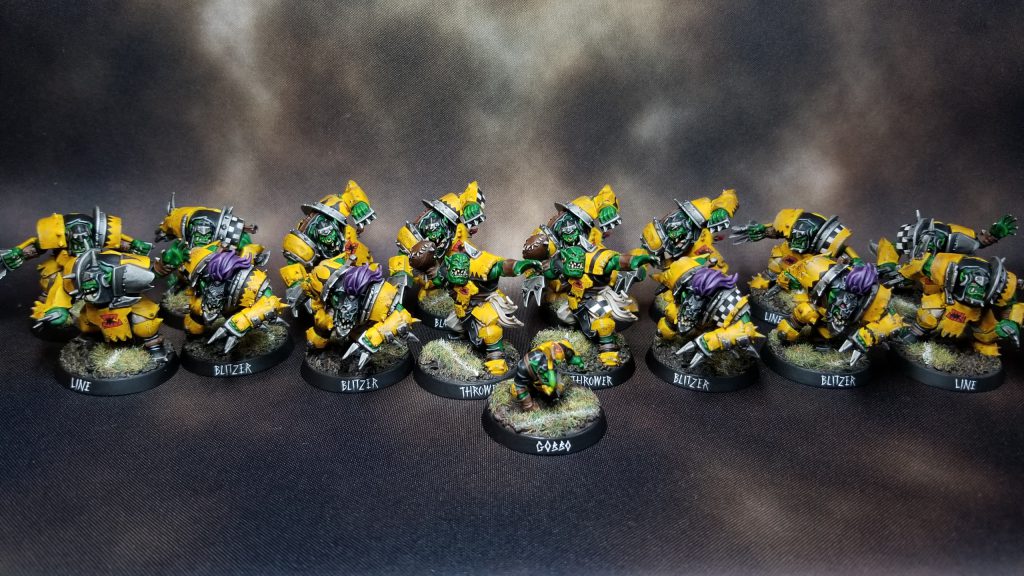Game Management is the strategic, match-level skill of Blood Bowl, as opposed to the turn-by-turn, block-by-block, tactical art of Blood Bowl. At its heart it is the skill of achieving the best possible result in the game through a combination of turn management and score management. In this article I’m going to explain those concepts and give you some practical tactical tips to achieve them.

What does a game-managed match look like?
In Blood Bowl, winning the game at a high level normally means achieving a 1-0, 2-0, or 2-1 result. That is a natural consequence in a game where players have limited turns, most teams have fairly limited movement, and when risk faces us at every action. We have all seen and played in games with much higher scores, but typically that is the consequence of the fickle hand of Nuffle, or one or both opponents having no particular gameplan.
So what’s the typical story of the games ending in the above scores?
- 1-0 – I scored on my drive, taking as much of the half as possible to do so. My opponent did not score in the single turn I left them. They then failed to score on their drive during the second half.
- 2-0 – I scored on my drive, taking as much of the half as possible to do so. My opponent did not score in the single turn I left them. I then stole the ball off of them on their drive during the second half and scored myself.
- 2-1 – My opponent began with the ball and scored on their drive. I was able to score in the turns they left me in the first half. I then scored on my second half drive, taking as much of the half as possible to do so. My opponent did not score in the single turn I left them before the game ended.
It all seems so simple when written like this, and of course, there is a world of tactical skill involved in achieving the results described in the above matches. But at the strategic level, these are what games that have been won with Game Management look like. We have used a combination of time management and score management to:
- Burn the clock on our drive so that once we score, our opponent has limited time to respond
- Created situations where we can simply defend to secure victory, or forced our opponent to take risks if they want to win.
- Created situations or taken advantage of situations in which we had time to respond to our opponent’s score with one of our own.
Now let’s break down how we actually play the above kind of drives.

Offense
On offense we have two situations we expect to encounter regularly that will help us achieve our game management goals:
- Scoring quickly (1-3 turns)
- Scoring as slowly as possible (8 turns)
When we enter a match, we need to have an idea how we achieve those goals with our particular team.
Scoring Slowly
Every team in the game can score slowly, whether that’s something that comes naturally, such as a slow, grinding, Orc cage; or something that requires a little restraint and finesse, like an Elf screening and stalling game.
The Elf stall is a tactic for the connoisseur. Some might consider it an abomination. But Elves (and other agile or fast teams) are just as well equipped to frustrate opponents and drag out drives as they are to run it in in two turns. The same mobility and agility that lets them create screens and keep opponents at arms’ length on defense can be used to prolong offensive drives. In fact one of the best ways of approaching this tactic is to get within scoring distance and then imagine you are defending your opponent’s end zone.
One of the hardest decisions you will have to make when trying to score slowly is what to do when the position starts to turn against you; either because your opponent is doing a lot of damage to your team, or because they seem to have a good opportunity to hit the ball. We’ll touch later in this article on some points to consider when making this decision.
Scoring Quickly
Scoring quickly is another matter, and many teams have more limited capabilities in this respect.
There have been many guides and much discussion about one-turn scoring. FUMBBL has an excellent list. If your chosen team is one of those that has a relatively simple one-turning method (I would consider almost all of the teams that have either an MA8 player or who can Throw-Team Mate to be in this category) then you should absolutely know the mechanics, and I would suggest you just practice it on your own to embed the general setup and process in your mind.
For two-to three turn scores, every team in the game is theoretically capable, though of course some have it much easier than others. For the slower and less agile races the two main challenges will be
- Getting players within scoring range whilst also protecting them
- Ensuring that you have enough movement and passing range to move the ball between the eventual kick-off landing spot and your scorer
This is highly situational Blood Bowl, so I’ll leave the specific advice there, but the main thing is to think a turn (or two) ahead so that you have enough movement range to at least have the chance to accomplish your goal, no matter how hard it might be.

Defense
On defense we again have two common situations we expect to encounter:
- Preventing our opponents from scoring without expecting to get the ball ourselves (A shutout).
- Turning the ball over and creating a defensive score
Just as with offense, you want to have an idea of how your team can achieve these goals, and particularly for defensive play, you need a keen understanding of how your opponent’s team plays so that you understand what you are trying to stop.
Shutout Defending
The two keys to this kind of defense are patience and restraint. If you push your players at your opponent, base them up, and create pressure, it might well have a certain kind of effectiveness, but it will also give them more scope to counter-block and outmaneuver you. The higher up the pitch you defend, the more likely it is that your opponent can get a player deep behind you and out of reach. Some fast offensive teams will actively fish for this kind of opportunity by trying to draw you towards them. If you are controlling and managing the game you must resist these temptations and play to your own tempo.
Your best tool to help this kind of play will be to cause damage. If you are able to use your blitz each turn to pick off an opponent, or even stun them, you will quickly limit their ability to play around or through you. Similarly, do not give up cheap blocks that let them gain the numbers advantage.
Defensive Scoring
This is the speciality of Blood Bowl’s agile races, and every BB veteran will know the sinking feeling of seeing a Blitz! Kickoff result against a Skaven or Wood Elf team. But there are multiple ways for all teams to create defensive scoring opportunities.
Whatever your race, defensive scores are primarily achieved by applying pressure. This means playing actively and aggressively, closing the space around your opponent and forcing them to roll dice, hopefully burning their rerolls or causing turnovers that give you opportunities to strike.
For agility teams, as we have touched upon, the easiest way is to apply pressure very early at kick-off, ideally by trying to separate the opposition ball-handler (and their cage or defenders) from the rest of their team. If your opponent manages to consolidate their position, you may need to base their cage or screens to keep players around the ball carrier and continue to pose the threat of a cage-dive. This is a risky proposition for lightly-armoured teams but if you have determined you need to find a defensive score this remains an effective and frustrating tactic for your opponent.
For bashier teams, basing your opponent, forcing them to make one-dice blocks or dodges to reposition each turn, or as always, causing damage, are great ways to apply pressure. You must still be mindful of faster teams’ ability to breakout and reposition against you, but any snake-eyed dodge can turn a position heavily in your favour when you have your opponent marked up.

Adapting your game
As we all know, Blood Bowl is a game in which things rarely go to plan. As such, the two most important skills to ally to Game Management are the ability to continually assess the state of the game, and the ability to know when it is time to change your plans.
Understanding the game state
The game state is a reflection of the balance of all the various resources and conditions that are in play at any particular moment. For example:
- What’s the score?
- Who has more players on the pitch?
- Who has more turns or possessions left?
- How many Rerolls does each team have remaining?
- What inducements are still in play?
- Are there any (un)favourable pitch or weather conditions in play?
By being able to assess the balance of these factors between ourselves and our opponent, we can get a good feel for where the balance of power and opportunity in the game lies, and inform our decisions about our ability to achieve our game management goals, and if need be, change them.
Changing your plans
Let’s look at some examples of when and why you might decide it is time to change your plans.
You might be trying an Elf stall but have taken so many KO’s that your offensive position is in danger. Scoring a little earlier here to ensure you do actually score, and give yourself the best chance to get players back to mount a more aggressive defence might be your best strategy.
You might be planning an 8-turn drive with your Black Orcs and then find your Goblin opponent has put all their Secret Weapons on the field against you. In this case, a quicker score that forces the Secret Weapons off the pitch might well be a more effective strategy that snowballs the game in your favour.
You might be planning a shutout defense, but then notice a key flaw in your opponent’s position that enables you to pressure them hard and hit the ball.
You can no doubt think of examples from your own games, and retrospectively reviewing your decisions at key points in the game, or, even better, talking them over with your opponent after the match, can really help to develop your instincts. The key thing is to always bear in mind your overall game management goals and the game state at the moment. Will your current strategy see you on course to win the game or get the best result possible? If not, it’s time to take a step back and think again.

Wrapping Up
Game Management is a concept that is well worth taking specific time to think about, whether you are a newer player, or want to raise your game, or think you may have fallen in to bad habits, or if you find that you feel a little rudderless when playing. Blood Bowl is a game in which a lot of discourse can be focused on very specific low-level decisions like skill choices or roster builds, but putting some mental distance between the minutiae of the game and our high-level goals can really help the thinking process when we sit down to play a match, and ensure we don’t get lost down a tactical rabbit hole.
I hope this article will help to give a framework for that thought process, and I wish you all the best in your strategic bowling!
As always if you have any questions or suggestions about Blood Bowl, please drop us a line at Contact@Goonhammer.com.


